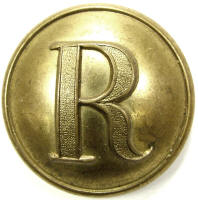
A virtual examination of artifacts of the American Civil War
 |
Ridgeway Civil War Research Center, A virtual examination of artifacts of the American Civil War |
| Civil War Artillery | |
| by Harry Ridgeway |
| Mines and Torpedos. Research Center: Artillery6200-MinesTorpedos, Details click: http://relicman.com/artillery/Artillery6200-MinesTorpedos.html. |
| Confederate platform torpedo, and 18 inch ball used to anchor frame torpedo. Although contemporary accounts describe these as "torpedoes" these devices were completely immobile. The "frame torpedo" was mounted on a platform in the shipping lane and depended on a ship to hit it. Note that the device was made in two parts, the seam around the middle was threaded and assembled on arming. This presumably would create a point of weakness, forcing the charge to blow upward to inflict maximum damage on the ship's bottom. The fuze is a pressure sensitive fuze, and this is smashed. Two of the bolts used to fasten the device to the platform are present, both are bent. There is a side hole filled with an iron bolt, and sealed with a leather washer, this may have been used to fill the device once the fuze was installed. When the iron bolt was first loosened it revealed that the torpedo was completely empty inside. The torpedo field was cleared after capture by the Federals, and this example was found on the banks near the field. It had probably been pulled from the platform, this might explain the bent bolts and the smashed fuze, then abandoned. The rest of the torpedoes were apparently recovered and most were taken to West Point for analysis, where they reside today. This torpedo field was located near Chapins Bluff on the James River and both the frame torpedo and an 18 inch ball were recovered together on the banks near this bluff. The report of its capture and a schematic drawing are both published in the "Official Records of the Union and Confederate Navies", Series I, Volume 7 pg. 543. The schematic shows a line of 36 frame torpedoes, followed by a line of 36 floating torpedoes, the latter was tethered to 18 inch balls used as anchors. The 18 inch ball is made as a typical cannon ball, open cavity and tapered hole. There was no effort to develop a cannon or a mortar of this caliber, this seems strange design for an anchor, but it would have been relatively easy to manufacture and get into the field quickly. The report clearly shows that 18 inch balls were used to anchor the line of floating torpedoes. Possibly this one was pulled from the torpedo field with force, then abandoned, most of the floating and the frame torpedoes were taken to West Point Foundry where they were disassembled and analyzed, and most are still there today. Torpedo measures: length 24in., body width 12in., 400 lbs estimated. Ball is 18inch diameter, 250lbs estimated. Research Center: Artillery6211-MinesTorpedos, Reference: "Official Records of the Union and Confederate Navies", Series I, Volume 7 pg. 543. Reference: "Torpedoes, Another Look at the Infernal machines of the Civil War", by Michael P Kochan, and John C Wideman,page 52, actual item photographed. Reference: Artillery Fuses of the Civil War, by Charles H Jones, page 132, actual example photographed.. Details click: http://relicman.com/artillery/Artillery6211-MinesTorpedos.html. |
| Fuse for torpedo, Savannah style, and covering cap for Raines pressure sensitive fuse. A cache of these fuses, unused, was found near Savannah, and nowhere else. Presumably they were intended for use in torpedos in the Savannah River. Diameter of threaded throat, tapered to 1.3in., length 4.5 in. Recovered: Savannah cache Ref: This discovery was documented and explained in North South Trader, December 1981. Fuze measures 4.5in. overall.. Research Center: Artillery6221-MinesTorpedos, Details click: http://relicman.com/artillery/Artillery6221-MinesTorpedos.html. |
| Short fuse and fragment from 8 in. land mine. and land mine fuse, loading plug. The fragment has the curvature equivalent to an 8 in. ball, but is thicker than the typical 8 in. ball. The fuse fits the big fuse hole, then there is a smaller hole right beside it, also threaded. The fuse section is 42mm in diameter, and 46mm tall It has a smaller threaded section on the bottom and a smaller yet threaded section above topped by a square nut on top. The D&G book lists a land mine that is 5.69 in. and another that is 9.88 in.. The curvature of this frag clearly matches an 8 in. ball. (7.88 approx.). The fuse appears to be part of a fuse and not the whole fuse. Yet it fits the larger of the two holes, which means that whatever else there is was screwed onto either the top or bottom, where it is recessed. The design does not seem to match any of the drawings presented in the D&G reference. Recovered: near Fort Blakeley Alabama Frag is from 8 in. ball. Research Center: Artillery6231-MinesTorpedos, Ref: Dickey & George, Field Artillery (1993 Edition), pg. 510. Details click: http://relicman.com/artillery/Artillery6231-MinesTorpedos.html. |
| Ridgeway Civil War Research Center, A virtual examination of artifacts of the American Civil War. Artillery Research center, artillery, click: http://relicman.com/artillery/Artillery0000-Index.html. Research center, artillery, click: http://relicman.com/artillery/Artillery0000-Index.html. |
| Civil War Relicman, Harry Ridgeway, Civil War artillery, Relicman sales catalog. Click here: http://relicman.com/artillery/RelicmanSalesArtillery1.html. Artillery for sale: http://relicman.com/artillery/RelicmanSalesArtillery1.html. |